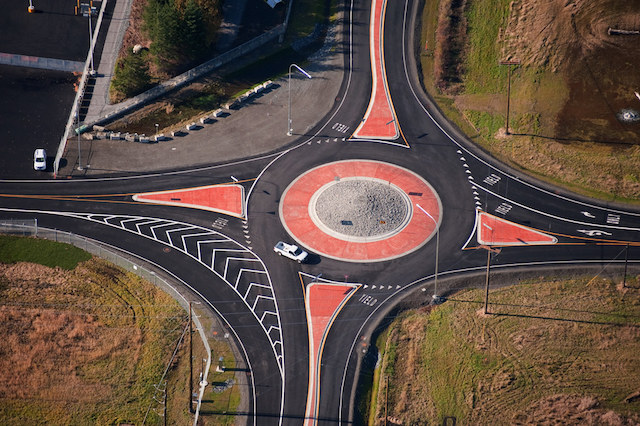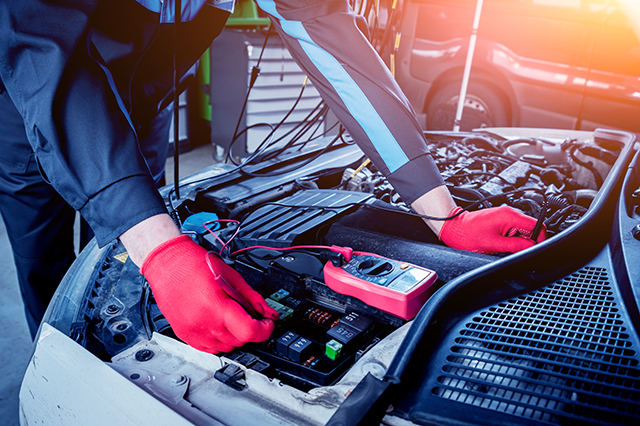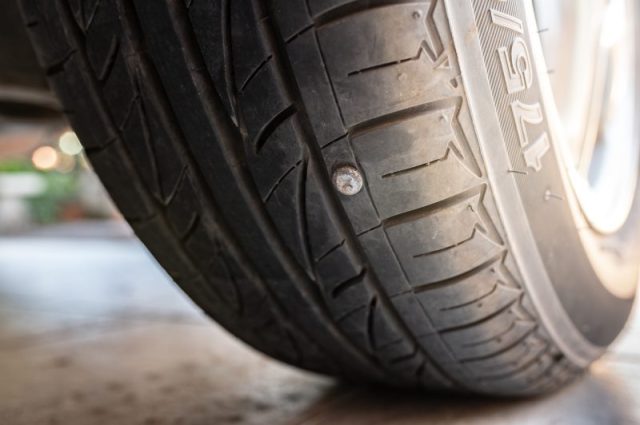Roundabouts – some people like them, many people don’t. No matter how you feel about these roadway features, you should get used to them, as they’re increasingly becoming the modus operandi of American intersections. There are nearly 8,000 roundabouts in the U.S., including hundreds scattered across the Northeast, according to transportation engineering firm Kittelson & Associates.
Why the switch? Proponents say roundabouts have safety, environmental and financial advantages over traffic signals and stop signs. With that in mind, it’s likely that these road features will only become more common.
But navigating can be a tricky feat, especially if you’re not accustomed to them. Here’s everything you need to know about how to use a roundabout safely.
What Is a Roundabout?
A roundabout is a circular intersection in which vehicles travel counterclockwise (in the U.S.) with entering traffic yielding the right-of-way to circulating traffic.
These roadways have been popular overseas, particularly in Europe, for decades. However, they have only recently been widely adopted here in the U.S. The reluctance can likely be attributed to the negative response American drivers had with traffic circles and rotaries built in the first half of the 20th century. These features were similar to roundabouts but had design flaws. The connecting rounds entered the circle at abrupt right angles and in many cases vehicles within the central circle had to yield to those entering. These factors led to safety and traffic issues.
The Benefits of Roundabouts
According to the U.S. Department of Transportation, more than half of all fatal and injury-causing car crashes occur at or near an intersection. Studies of intersections have shown that converting traffic signals or stop signs to roundabouts can reduce all crashes by nearly 50% and injury crashes by up to 80%.
Roundabouts have two significant advantages over traffic signals and stop signs: They are safer and create less traffic. There are several design elements that make roundabouts a safer option. When a vehicle approaches a roundabout, the driver is forced to slow down in order to navigate the turn of the circle. Roughly one-quarter of all traffic fatalities are speeding-related. A slower car is a safer car.
Additionally, roundabouts nearly eliminate the chance of any of the most severe types of crashes – right-angle, left-turn and head-on collisions – from occurring. Most car crashes (including a vast majority or fatal crashes) involve vehicles traveling in different directions.
On the topic of traffic direction, since cars all move in the same direction in a roundabout, the stop-and-go nature of traffic flow that occurs at traffic signals and stop signs is significantly reduced. Research has proven that traffic flow improves after roundabouts have replaced traditional intersections. As an added bonus, roundabouts create less idling, which means fewer vehicle emissions (good for the environment) and less fuel consumption (good for your wallet).
The Dangers of Roundabouts
Although roundabouts are considered the safer intersection option, they can be potentially hazardous to some drivers, particularly older drivers.
“The single greatest concern in accommodating older road users, both drivers and pedestrians, is the ability of these persons to safely maneuver through intersections,” according to the Federal Highway Administration. The FHA also states older drivers may have difficulty in situations involving complex speed-distance judgments under time constraints, and are much more likely to be involved in crashes where the drivers were either traveling too fast for the curve or were surprised by the curved alignment. This all adds up to roundabouts being a significant safety risk for older drivers.
Roundabout Rules
How to Use a Roundabout
In theory, roundabouts are simple to understand, but they can be difficult to navigate if you’re unfamiliar. Upon approaching the intersection, a vehicle yields to traffic already within the roundabout. Vehicles already in the roundabout have the right of way. When there is a safe amount of space, you can enter. Remember, a yield sign is not a stop sign – if there are no cars in the roundabout, look around for pedestrians and bicyclists and proceed in.
Once in the roundabout, circle the road until you reach your desired exit. If you want to turn right, take the first exit; straight, the second; left, the third; and a U-turn, the fourth.
When there’s only one lane, it’s fairly straightforward. Things can get confusing in a multilane roundabout. In this scenario, the vehicle should be in the right lane to turn right or go straight, and in the left lane to go straight, turn left or make a U-turn. There will usually be signs leading up to the roundabout indicating which lane to occupy. Also remember to use your turn signal.
Roundabouts can be tricky for even the most experienced drivers, let alone new ones. Learn to become a lifelong safe motorist at AAA Driving School or through AAA’s Defensive Driving course.
How do you feel about roundabouts? Do you find them confusing? Let us know in the comments below.
24 Thoughts on “How to Use a Roundabout”
Leave A Comment
Comments are subject to moderation and may or may not be published at the editor’s discretion. Only comments that are relevant to the article and add value to the Your AAA community will be considered. Comments may be edited for clarity and length.



















I live near the worst roundabout in the world, the one in front of the Bourne Bridge!
In my experience, they are great for cars in light to moderate traffic levels, but work badly in high traffic levels. A car leaving on a road while using a turn signal creates a gap for another car to enter from that road. Otherwise it can be very difficult to enter from a minor road.
Roundabouts are very scary while bicycling. Doing anything other than a right turn requires crossing several roads while looking backwards for a car about to exit there.
Nowhere in the article does it mention or discuss pedestrians. When roundabouts occur in residential neighborhoods or where pedestrians are present, drivers are typically not thinking about them as you point out there are many other complex calculations necessary to navigate a vehicle through one. Pedestrians have no clear, designated signal phase time which they would recognize as “their turn” to enter and cross the roadway, and instead are left to hoping they can find a gap in the approaching traffic for a chance to cross the street. If no gap presents itself after a while, pedestrians would typically become frustrated and do something unsafe. Pedestrian-activated signals in a roundabout defeat the idea of free flowing movement reducing idling and improving air quality. Roundabouts where there is no possibility of pedestrians being present are usually a good idea to improve traffic flow. Roundabouts where vehicles and pedestrians must comingle, bad idea. It’s not always only just about the movement of cars.
As a driver I think roundabouts are great. However as a pedestrian there a misery; a constant stream of moving vehicles in all directions with no safe place to cross.
Met my first roundabout in Holland in 2004, and I really was shocked. Think they are a great idea.
USE SIGNALS.. (US) left signal if staying in rotary; right one when exiting. It takes the guess work out of when to enter; helps the flow of traffic to get cars into the rotary as soon as possible. I am concerned for pedestrians. If there will be crosswalks integrated there should be on-demand pedestrian lights.
I often travel MA 203 (the Arborway) to medical appointments in Boston. The roundabout near the Arboretum has been reconfigured & is actually WORSE than before. The rotary portion contains multiple lanes, as previously; however, the exit point I use was reduced from 2 lanes to 1. The road markings serve only to confuse drivers regarding which lane to use. I’ve seen too many near misses in just a few months. Just AWFUL!
Americans are extremely unfamiliar with roundabouts and have no idea how to safely and courteously negotiate one. American drivers are basically discourteous, always in a hurry and prone to road rage, a deadly combination especially where roundabouts are involved. They need to open their minds to the concept of actually politely sharing the roadway and slowing it down a little. Roundabouts are increasingly becoming more popular in America with over 7000 of them towards the end of 2021. Roundabouts can actually be a good thing once Americans understand how to utilize them. Highway departments around the country need to start issuing information packets on how to safely and courteously negotiate them. Schools should be required to educate student drivers in the use of them. But at the moment, they are more frustrating to us Americans than the pre-eminent slow, elderly, Sunday driver out for a ride.
I’m the older driver they mention – it’s harder for me to judge the distance and speed of the cars already in the roundabout. As I get more accustomed to them that gets a bit easier. I’d still be very happy to stop at a stoplight intersection, though!
We in the bicycle safety wing of traffic management are still wondering how to encourage automobile drivers to yield appropriate right of way to bicycles in the roundabout. Drivers to not see what they are not looking for. Strobe lights? Paint guns? Not serious, but . . . .
Can AAA lobby to have demonstration of navigating a roundabout safely be part of a driver’s test wherever possible? Roundabouts are so sensible but people’s alarm about them is unnecessary and potentially dangerous.
Roundabouts are the worst things to exist they are putting them all over Sarasota FL and their full of broken taillights and pieces of bumpers , to confusing to most ????
I avoid roundabouts whenever I can. Too stressful.
I love them but wish they didn’t exist because so many people don’t understand how to use them & make driving situations in the roundabout very dangerous. People who know exactly how to operate one seem to think everyone else does also. Tourist who aren’t used to them at all, especially when they are following a GPS, are a huge hazard.
I traveled to Cape Cod once a month for years. I find that the drivers IN the roundabout drive quickly so no one can get in front of them! so then what does one do?
terrible to navigate and traffic backs up when it didn’t before. There is a hill right after the roundabout and trucks have to come to almost a complete stop entering the roundabout then have to creep up the hill. Before they could quickly climb the hill
There’s one near us that has a huge volume of traffic in the morning and afternoon rush hours. Roads in the main directions get backed up, with lots of stop and go traffic. Getting into the roundabout is difficult. What can be done about this? My opinion is that the main road needs a separate lane for traffic going straight through, with no lights or turns. That would keep these out of the roundabout.
Traffic circles, roundabouts and rotaries are not tricky, in Watford England there is a magic roundabout, many small roundabouts in a large roundabout, that scares some people. We need traffic cameras and drivers will be on their best behavior.
I like and think more roundabout’s are a good thing
In general I like them as not having to complete a full stop or wait for the light to turn green when there is NO other traffic. When it is full or very busy I don’t like them especially when I’m not sure of when my exit will be coming up to be in the correct lane.